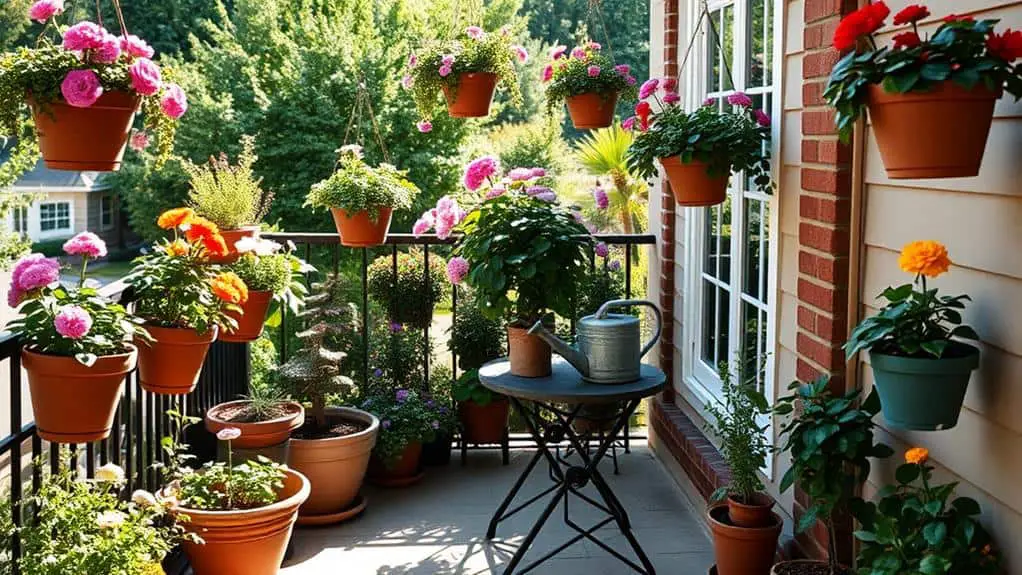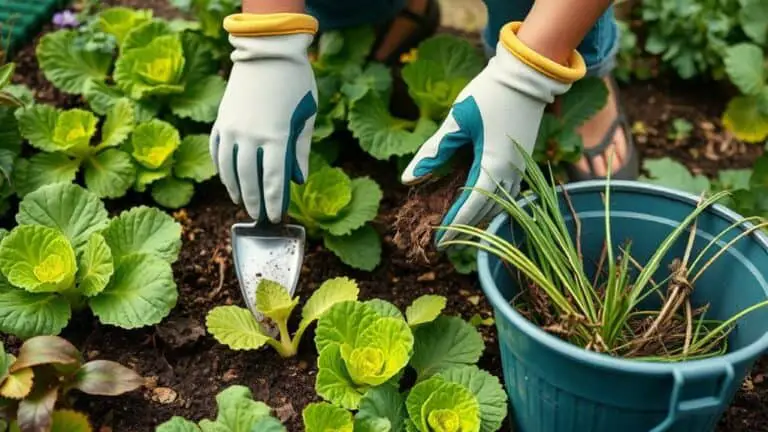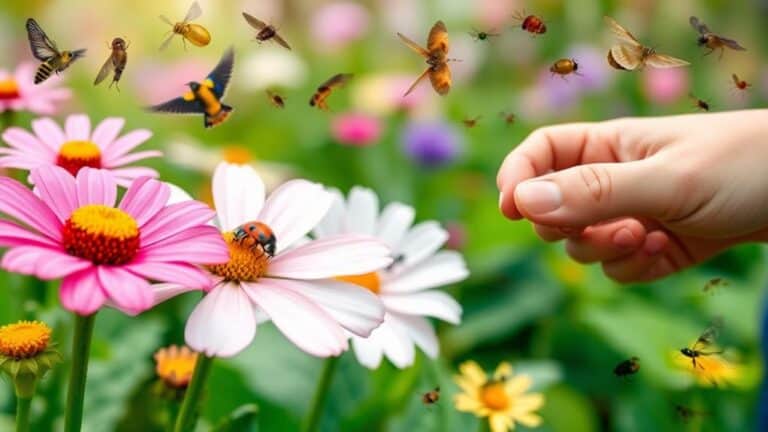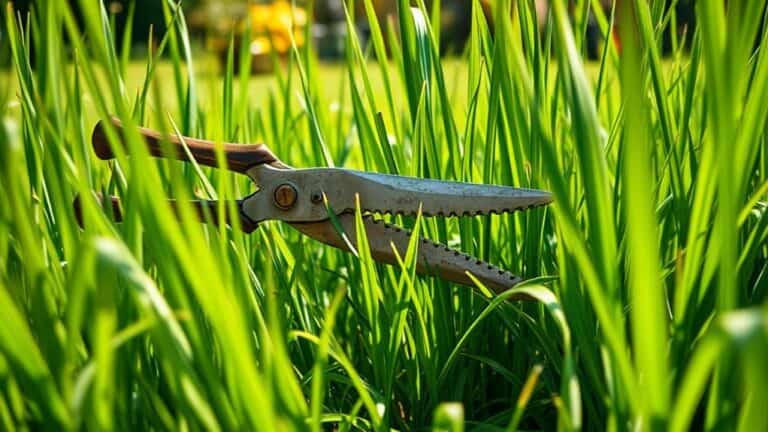How To Garden On An East Facing Balcony
Gardening on an east-facing balcony can be both relaxing and fruitful, but it requires some planning to make the most of that gentle morning sunlight. I've found that understanding the unique light patterns is essential for selecting the right plants. Have you ever wondered which plants thrive best with just six hours of morning light? Let's explore the types of leafy greens and herbs that not only flourish but also add a touch of green to your space. You might be surprised at how simple adjustments can lead to a thriving balcony garden.
Understanding Sunlight Patterns
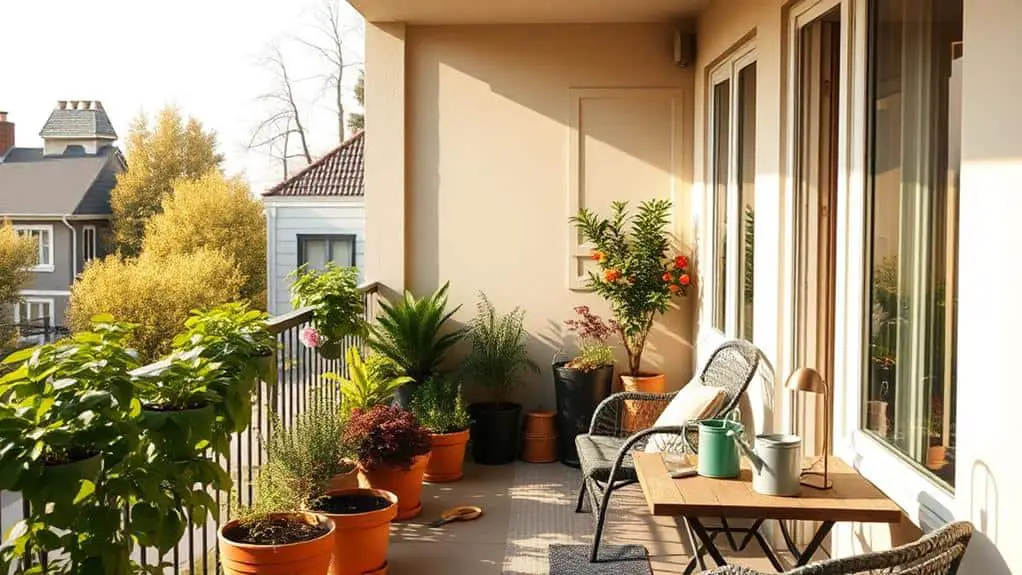
When planning a garden on an east-facing balcony, understanding sunlight patterns is essential. Your balcony gets about six hours of sun in the morning, which is perfect for plants needing moderate light.
I find that leafy greens and herbs thrive here since they don't require intense sun exposure or deep root space. The morning sun is gentle, unlike the scorching afternoon sun, so it won't stress your plants.
By tracking the hours of sun your balcony gets throughout the day, you can place plants where they'll grow best. Seasonal changes also affect sun exposure, so keep an eye on how light shifts throughout the year.
This helps guarantee your plants stay healthy and grow well all year round.
Reviewing Regulations and Permissions
While understanding sunlight patterns is key, it's also important to review your building's regulations and permissions before starting a garden on your east-facing balcony.
First, check your condo association rules and any building guidelines. Confirm weight restrictions for planters and structures; exceeding these can be unsafe and costly.
Inquire about permissions required for attachments to railings or walls. Some buildings have specific guidelines for these features.
If you're considering vertical gardening elements like trellises or living walls, verify if prior approval is necessary.
Finally, sketch a layout of your intended garden to visualize pot placement and guarantee it adheres to the balcony's regulations and available space.
Following these steps will set you up for success.
Choosing Suitable Plants
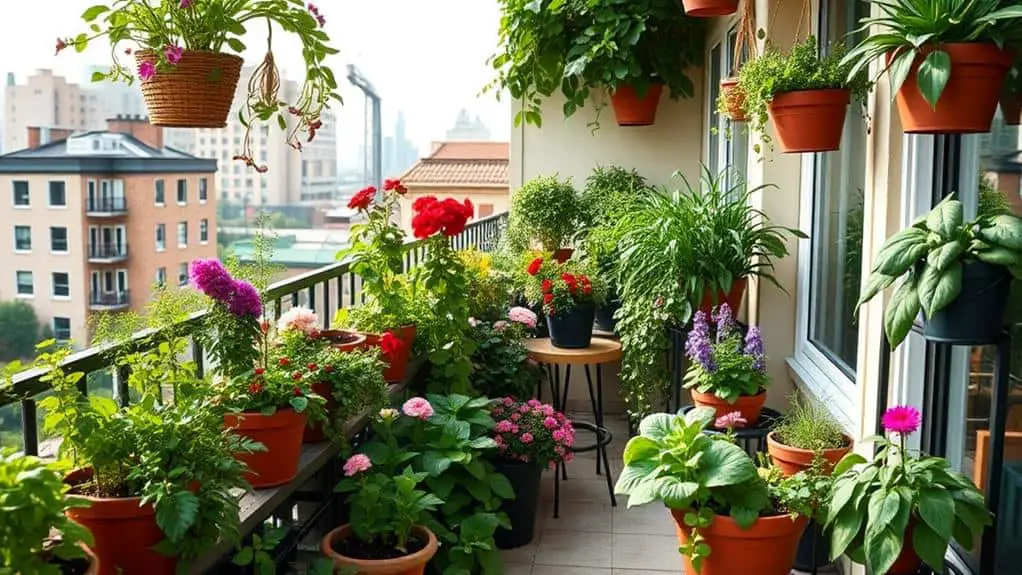
When choosing plants for your east-facing balcony, start with flowers and vegetables that love moderate light.
Ferns and hardy geraniums will thrive with the morning sun, while leafy greens like spinach and kale will flourish without the intense afternoon heat.
Don't forget about herbs like parsley and mint, which do well in this environment, adding both beauty and flavor to your garden.
Ideal Flower Choices
Selecting the right plants for your east-facing balcony can transform it into a vibrant and thriving garden space.
Some ideal flower choices include shade-loving flowers like clematis, which flourish in morning sunlight and can also add privacy. Morning glory is another excellent option, as it opens its blooms early, bringing vibrant color to your garden.
Coneflowers are perfect for east-facing areas, adapting well to partial shade and attracting pollinators. Hardy geraniums thrive in the moderate sunlight of an east-facing balcony, providing continuous blooms with minimal care.
For an added touch of privacy and ornamental value, consider incorporating berberis shrubs. These plants not only enhance the aesthetic appeal but also thrive in shaded areas, making your balcony a beautiful retreat.
Optimal Vegetable Selection
Gardening on an east-facing balcony offers a unique opportunity to grow a variety of vegetables that thrive in morning sunlight and cooler temperatures.
When considering ideal vegetable selection, focus on plants that prefer moderate sunlight and don't require full sun. Leafy greens like spinach and lettuce are perfect options, as they flourish in gentle morning light.
Other great choices include:
- Peas and green onions: They thrive in moderate sunlight and cooler mornings.
- Brassicas: Vegetables like cauliflower and broccoli grow well in partial shade.
- Garlic: It requires less sunlight and performs excellently in cooler conditions.
- Herbs: Parsley, mint, and thyme are ideal for adding flavor while thriving in moderate sunlight.
Selecting Appropriate Pots
Choosing the right pots for your east-facing balcony can make all the difference in your gardening success. When selecting appropriate pots, focus on ones with good drainage to prevent waterlogging. Lightweight materials like plastic or fiberglass are ideal, making it easy to move them around as needed. Self-watering pots are fantastic for maintaining consistent moisture, especially with the morning sun your balcony receives.
| Pot Type | Benefit | Ideal For |
|---|---|---|
| Plastic | Lightweight materials | Herbs, small plants |
| Fiberglass | Lightweight materials | Medium-sized plants |
| Self-watering | Consistent moisture | Water-loving plants |
| Light-colored | Reflects heat | Heat-sensitive plants |
| Deep pots | Root space | Leafy greens |
Pick pot sizes based on root needs; for example, herbs need smaller pots, while leafy greens need deeper ones.
Preparing Soil and Fertilizer
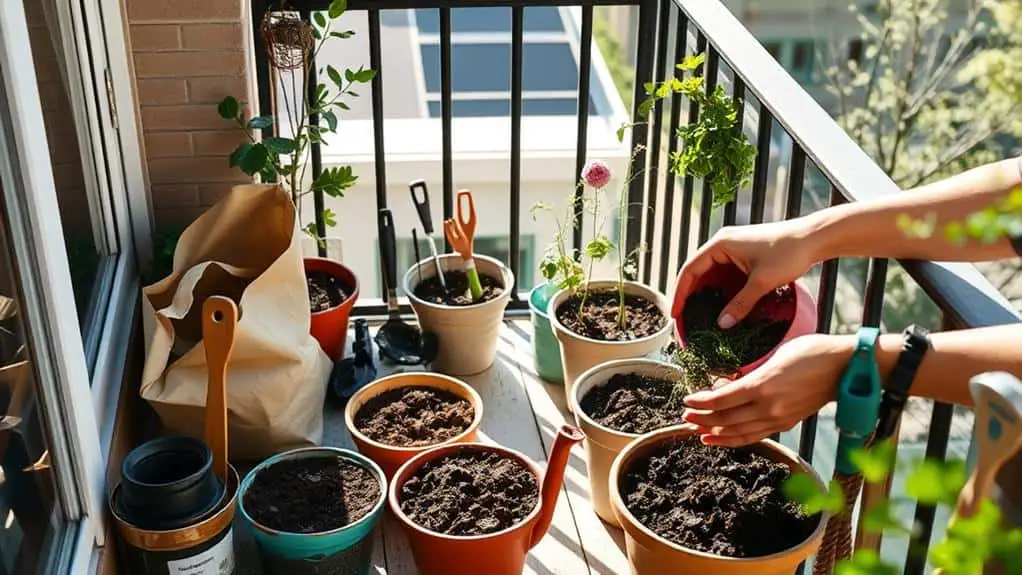
To get the most out of your east-facing balcony garden, it's important to start with the right soil and fertilizer. I always use a lightweight potting soil mix, perfect for container gardening because it allows good aeration and drainage.
Mixing in topsoil, vermiculite, and compost guarantees balanced soil that retains moisture and promotes healthy roots.
- Use lightweight potting soil for aeration and drainage.
- Mix topsoil, vermiculite, and compost for balanced soil.
- Monitor and replace container soil annually.
- Apply slow-release fertilizers every 2-3 months.
Don't forget to check for proper drainage to prevent root rot and adjust watering based on weather.
Organic pest control methods help keep your garden healthy without harsh chemicals. Happy gardening!
Planting Techniques and Tips
When setting up your east-facing balcony garden, place shade-tolerant plants like leafy greens where they can soak up the morning sun.
Use lightweight potting mixes to guarantee your plants have proper drainage and moisture retention, which is essential for container gardening.
Keep an eye on soil moisture and adjust your watering based on the weather, as this exposure can vary in humidity and wind.
Optimizing Plant Placement
Maximizing the potential of an east-facing balcony garden starts with smart plant placement.
To balance sun and shade, position shade-loving plants closer to walls. Ferns and impatiens thrive with limited morning sunlight.
Place sun-loving plants like marigolds and petunias furthest from walls to soak up more morning sun.
Don't forget to use vertical space! Climbing plants on trellises or railing planters save floor space and enjoy the morning sun.
Grouping plants with similar needs together makes care easier. Leafy greens like spinach and lettuce love the moderate light of an east-facing balcony.
Always monitor seasonal changes to adjust plant placement for the best sunlight exposure.
- Position shade-loving plants near walls
- Place sun-loving plants away from walls
- Utilize vertical space
- Group plants with similar needs
Effective Watering Strategies
While smart plant placement sets the stage for a thriving east-facing balcony garden, ensuring your plants receive the right amount of water is just as important.
Effective watering strategies are essential, especially since morning sunlight and wind can dry out your plants quickly. I recommend using self-watering pots, which have a water reservoir to maintain moisture levels, reducing how often you need to water.
You can also set up a drip irrigation system for consistent moisture. Remember to check the soil moisture by feeling the top two inches; water when it's dry to the second knuckle.
Mulching helps retain moisture and regulates temperature, minimizing the need for frequent watering. These tips will keep your balcony garden healthy and happy!
Watering and Irrigation Methods
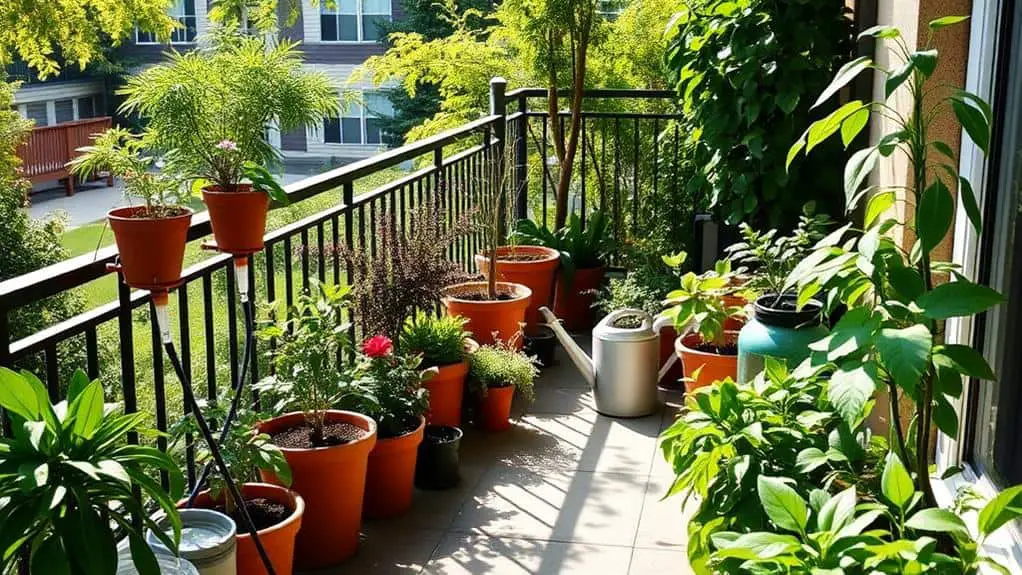
Gardening on an east-facing balcony presents unique watering challenges that require some strategic planning.
To keep your plants happy, monitoring moisture levels is essential. Here are some tips to help you manage watering effectively:
- Self-watering pots: These are fantastic for maintaining consistent moisture levels, reducing the need for frequent manual watering.
- Drip irrigation system: This method delivers water directly to the root zone, cutting down on evaporation and preventing fungal diseases.
- Check soil moisture: Insert your finger about two inches deep. If it feels dry, it's time to water.
- Weather adjustments: Increase watering frequency during hot spells and reduce it during rainy periods.
Managing Wind Exposure
Strong winds can pose significant challenges when gardening on an east-facing balcony, particularly on higher floors. To provide effective wind protection, consider installing windbreaks like trellises or screens. These can shield your plants from harsh gusts while still letting in sunlight. Grouping sturdy potted plants together acts as natural wind barriers, protecting more fragile varieties behind them. Moving plants away from exposed edges especially during storms can minimize wind damage. Consulting an architect or gardening expert can also offer tailored solutions for your balcony.
Here's a quick overview:
| Tip | Action | Benefit |
|---|---|---|
| Windbreaks | Install trellises or screens | Shields plants from wind |
| Sturdy Potted Plants | Group together | Natural wind barrier |
| Relocate Plants | Move from exposed edges | Minimizes wind damage |
| Expert Consultation | Seek tailored advice | Structural wind protection |
These strategies can help keep your balcony garden thriving.
Designing for Aesthetics

To make your east-facing balcony beautiful and inviting, start by choosing a cohesive color scheme for your plants and pots that enhances the morning light.
Adding decorative touches like garden sculptures and fairy lights can make the space feel cozier and more personal.
Don't forget to create a comfy seating area with colorful cushions so you can enjoy your garden while relaxing.
Color Scheme Choices
Creating a cohesive color scheme for your east-facing balcony garden can greatly enhance its visual appeal. I recommend using a mix of complementary colors to create a harmonious look. For example, pair cool blues with vibrant yellows.
Choose flowering plants like morning glories or clematis in shades of purple or blue to match the soft morning light. This creates a serene atmosphere.
Colorful pots are also essential. Bright red or orange pots can add warmth to cooler-toned plants.
Consider trailing plants like petunias or lobelia in various colors to create a cascading effect. This enhances vertical space and adds visual interest.
- Cool blues and vibrant yellows
- Morning glories or clematis in purple or blue
- Bright red or orange pots
- Trailing plants like petunias or lobelia
Decorative Element Ideas
While selecting a harmonious color scheme sets the stage, integrating decorative elements can elevate the aesthetic of your east-facing balcony garden to the next level.
Use colorful pots and planters in various shapes and sizes to create visual interest. Adding fairy lights or lanterns will bring warmth and ambiance, especially during evening hours.
Don't forget vertical elements like trellises or decorative screens to support climbing plants, adding height and dimension. Garden sculptures or decorative stones can serve as focal points, providing personality and charm.
Remember, a cozy seating area with stylish outdoor furniture or cushions that complement your garden's color scheme will help you enjoy the space fully.
These touches make your balcony inviting and visually appealing.
Cozy Seating Area
A cozy seating area transforms your east-facing balcony into a personal sanctuary where you can unwind and enjoy your garden.
Choose comfortable seating options like a small bistro table and chairs or a cozy bench with weather-resistant cushions and pillows. This not only guarantees comfort but also adds visual appeal with a cohesive color scheme.
To enhance the space and create ambiance, consider adding some decorative elements. Here are a few ideas:
- Potted plants: Add lush greenery without overcrowding.
- Lanterns: Provide a warm, inviting glow.
- String lights: Create a magical evening atmosphere.
- Vertical or railing planters: Maximize space and maintain clear views.
Position your seating to enjoy the morning sunlight while staying shaded in the afternoon, guaranteeing both comfort and plant health.
Seasonal Care and Maintenance
Gardening on an east-facing balcony requires attentive seasonal care and maintenance to keep your plants thriving throughout the year. Each season has its own needs.
In spring, prune perennials and add compost to prepare the soil.
During summer, maintain consistent moisture levels, as the soil can still dry out quickly. This is essential for leafy greens.
Fall is the time for harvesting late-season vegetables like kale and spinach before the first frost. Add mulch to protect roots from the cold.
In winter, wrap pots with insulating materials to prevent root freeze, and check evergreens for water needs.
Don't forget the seasonal rotation of crops and cleaning containers to reduce pests and prepare for the next cycle.
Frequently Asked Questions
Is an East Facing Balcony Good for Plants?
Yes, an east-facing balcony's great for plants. With limited sunlight, I focus on plant selection. Shade-loving plants like spinach and clematis thrive here. A good balcony layout maximizes space for these varieties, ensuring they flourish.
Can You Grow Tomatoes on an East Facing Balcony?
You can grow tomatoes on an east-facing balcony, but choose shade-tolerant tomato varieties. Focus on container gardening, ensuring proper soil requirements and pest management. Morning sun helps, but you'll need to maximize light exposure and warmth.
What Is the Best Direction for a Balcony Garden?
I believe the best direction for a balcony garden is east-facing. This way, companion planting, container gardening, and vertical gardening thrive with morning sun. Plus, soil quality stays ideal without the harsh afternoon heat.
How Much Sun Does an East Facing Balcony Get?
An east-facing balcony gets around six hours of morning sunlight. For plant selection, choose ones with shade tolerance. Seasonal variations affect sunlight intensity, so monitor the patterns to guarantee your plants thrive year-round.
Conclusion
Gardening on your east-facing balcony can be a truly rewarding experience. With the right plants, pots, and care, you'll create a lush, green space to enjoy. Remember to monitor sunlight, water your plants properly, and protect them from the wind. Keep experimenting and adjusting as you go. Don't worry if things don't go perfectly at first—gardening is all about learning and growing. You've got this, and soon your balcony will be a beautiful, thriving garden!

